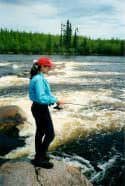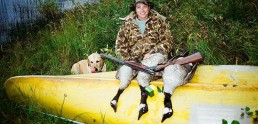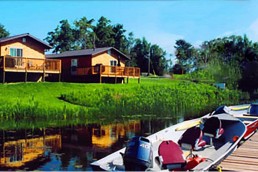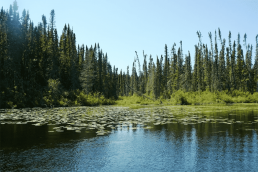An Ogoki River Adventure
by ‘Bobber’ Anne
It’s quiet. Then a rustling of yellow aspen leaves, and a sharp squawk of a faraway raven. And then that sound so familiar with the Ogoki River—Canadian honkers in flight up the river corridor. The land lives.
Dan Gapen Sr. and I had come back to the place he loves so much. It was mid-September and the waterfowl season had begun. Black ducks flew above the backwaters. Goldeneyes crowded the river channel and yellow- bellied walleyes swam below the rapids.
The air was crisp and the fall sun warm on one’s back. Life was good and we were back to fish and hunt.
The cabin stove at Leuenberger’s Harrogate Lake Outpost brought the smell of burning birch to fill the room. It was a good smell. I would further fill the cabin with the smell of frying bacon and cooking eggs. It was breakfast time.
“It’s sunrise and the day looks great!” I encouraged my partner to exit his sleeping bag.
“Anne, is that geese I hear?” inquired my hunting and fishing companion.
“Yup—and that’s breakfast you smell. Come and get it!” I told him.
We’d come back to the Harrogate outpost camp for a week of outdoor adventure. Not only would we fish its waters and hunt its population of waterfowl, but we’d also come to shoot underwater footage of walleye attacking our new lure, the Spin Bee. Even though the Ogoki River water hosts a discoloration from Tamarack trees, it’s clear enough to get great underwater film.
With Dan at the breakfast table I exited the cabin to sit on the steps and take in the fresh morning air. The camp ravens, three of them above me in a huge poplar tree, began to squawk their protest. Thumper, the Ol’ Man’s aging yellow lab, had followed me and was now perusing that very tree. Obviously, the black devils weren’t expecting Thumper.
With breakfast finished we headed downriver to take a count on the waterfowl population. We’d go all the way down to where the river rapids exited the backwaters, which we called the roundabout into Esser Lake. These five miles of river corridor usually holds a healthy population of honkers, black ducks and eastern goldeneyes. If my partner determined a shoot could be set up, we’d do so. If not we’d fish the lift area just above the rapids’ exit. Here, some of the biggest walleye had always been caught on previous trips.
Halfway through our trip, where islands split the river, Dan decided Thumper and I must exit the boat, walk in on a long backwater and await the waterfowl this area seemed to always carry. He would motor on down the main channel and turn back into the backwater channel to flush our prey.
It took Dan only four or five minutes to accomplish this. Then, as predicted, 12 honkers accompanied by a number of ducks rose up and headed toward the point
I’d selected. Three shots later from my Benelli 20-gauge shotgun, Thumper was retrieving the first of two honkers I’d collected. Tonight’s dinner was assured! Next I managed a duck out of a flock of six.
“’Bobber,’ how’d you do?” came my partner’s question, as he returned from being my flusher. Pleased with my results, he mentioned the next time a stalk was done,
I’d be running the motor and he’d be the gunner. That was great.
Headed downriver again, we did a little trolling with Spin Bees and collected two walleyes to add to our evening meal. Fried goose breast, fried walleye and potatoes were on the menu. With a can of baked beans it would be a dinner fit for royalty.
After catching and releasing a dozen or more good-sized walleye above the rapids, one near 8 pounds, we headed back upriver. On the way, as we rounded the islands, we were lucky enough to catch a cow moose and her calf crossing the river at midstream.

Next we’d do some underwater filming at a spot where the river exited Harrogate Lake. During our filming we cemented Dan’s theory on river zones as my underwater gear plainly showed the walleye holding close to bottom in a seemingly quiet water structure. See Dan’s articles on his series of new river structures called “River Zones” in upcoming issues of MidWest Outdoors. They will be featured in January, February and March.
We gathered an hour of underwater footage that day and videotaped about 14 walleye strikes on film. Later, as the sun tipped the western black spruce, we were serenaded by the Harrogate pack of wolves. That cow and calf moose better look out, for the bad boys of the Ogoki River were on the prowl. Our first day was complete, and just think, we had six more adventurous days to go!
There was one day when the wind switched to the northeast, and rain showers with snow pellets descended. Other than that, the other five days were repeats of day one. More ducks and geese were harvested. Walleye, one over 9 pounds, were caught and released during that time. One pike over 16 pounds came to boat, and one, a ten-pounder, tried to eat one of our Spin Bee-caught walleye. We filmed it all.
Not a single human was encountered—only the wolves, moose, beaver, otter and a fish-stealing mink that Thumper didn’t like. We fed an old wolf that greeted us at the lake narrows. He must have been a dethroned alpha male who’d been kicked out of the pack. The walleye scraps we fed him were much appreciated. It was obvious by his looks he was close to death.
During our days at Harrogate, we learned much about Dan’s theory on the river structures he begins to explain in these issues of MidWest Outdoors.
With the sounds of Leuenberger’s Otter float plane coming in on day seven, we were a bit sad but completely rejuvenated and ready to step back into our modern world.
I’d come to love and understand why my partner cherishes so much the world of Harrogate (which to this day he still calls Hargate.)
Until next month when I take you back to Canada on another adventure, this is “Bobber” Anne hoping you go forth into this wilderness world. There’s nothing like it to soothe your soul.
MWO
SHARE THIS POST
You may also like...
Did you enjoy this post?
You can be among the first to get the latest info on where to go, what to use and how to use it!
Dan Gapen
Considered one of the world’s leading river anglers, Dan Gapen, Sr. has shared his knowledge with MidWest Outdoors readers and viewers for more than 40 years. He is a member of all three Fishing Halls of Fame—International, National Freshwater, and Minnesota. He has an immense grasp of the world’s fisheries. He may be contacted at 877-623-2099.
@TheGapenCompany.



